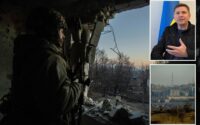Zodiac killer may have been more than one person: new doc
As if one Zodiac killer wasn’t scary enough — there may have been killers, plural.
The horrifying new theory, explored in the Peacock docuseries, “Myth of the Zodiac Killer,” premiering Tuesday, suggests a surplus of sickos may have been responsible for the various confirmed atrocities attributed to one mythical murderer.
The petrifying prospect comes roughly half a century after the late 1960s and early 1970s, when the Zodiac wreaked havoc upon the San Francisco Bay area.
Appearing on the scene in late 1968, victims appeared to be selected at random — meaning nobody was safe.
All the public knew was that in the space of about six months, the mystery ghoul was allegedly responsible for five grisly deaths — with two more attempted.
Even more chilling — the attention-seeker liked to advertise his dark deeds in the media.
Referring to himself only as “the Zodiac,” along with the symbol of a circle with a cross through it, he sent local news outlets a slew of confessional letters, as well as four complex ciphers to the San Francisco Chronicle — which weren’t cracked until 2021.

This behavior would continue well into the 1970s; in the end, he would claim to have killed no less than 37 people.
For half a century, the notorious killer — whose real identity remains a mystery — was believed to be a sole actor.
“It’s very unusual for cold cases to have this much information. But if you read all the police files, you see that there’s very little linking these crimes together. Different weapons, different M.O., different victim profile, even eyewitness statements, different locations -— or a trophy being taken from one, but none of the others,” director Andrew Nock told The Post.
“The letters are really the only thing that anchors these crimes together. There’s strong evidence to suggest that not only were the crimes committed by separate people, but the letters were written by more than one person as well.”
The timeline

The Zodiac’s known actions began with the slaying of two teenagers, David Arthur Faraday, 17, and Betty Lou Jensen,16 on Lake Herman Road in Benicia, California, Dec. 20, 1968. The high school couple on their first date had been shot dead inside their car.
Half a year later, on the Fourth of July, the Zodiac struck again. He shot Michael Renault Mageau, 19, and Darlene Elizabeth Ferrin, 22 inside their parked car at Vallejo’s Blue Rock Springs Park. Mageau survived while Ferrin succumbed to the gunshot wound.
The first letters were sent at the end of July 1969.
In those letters was a confession to the two murders — along with an ultimatum that he would kill “a dozen” over the weekend, if the Chronicle did not print his cipher inside its next issue. The paper complied on Aug. 2.
The Zodiac’s third and fourth acts in the following months are where the irregularities in the pattern began.

His next two victims, Cecelia Ann Shepard, 22, and Bryan Calvin Hartnell, 20, were stabbed mercilessly in broad daylight at Lake Berryessa in Napa County on Sept. 27, 1969. Hartnell survived but Shepard died days later.
While leaving the park, the killer — who was seen wearing a medieval executioner-style hood — wrote the dates of the previous two murders on the side of Hartnell’s car.
Then, on Oct. 11, a 29-year-old cab driver named Paul Lee Stine was shot by a passenger he was dropping off in San Francisco’s Presidio Heights neighborhood. The killer ripped off a piece of Stine’s shirt and sent it to the Chronicle as proof.
It was after Stine’s killing that the authorities rendered their first sketch of the Zodiac based on two child witnesses’ accounts.
A new witness

The description of Stine’s murderer is inconsistent with a man seen at Lake Berryessa, witness Linda Jensen, who is coming forward publicly for the first time, says on camera.
“There are other drawings that came out, of the Zodiac, that looked nothing like what I saw that day,” Jensen says, referring to the famed sketch.
Prior to the stabbings, Jensen was at the lake sunbathing with friends when a strange man had stalked the group and hid behind a tree for around 45 minutes. She said the group merely pretended he wasn’t there, for their own safety.
Notably, the picture that she describes shows major differences to the hair, eyes and facial features, compared to the image that ran after Stine’s death.

“He had very smooth, parted hair and combed [it] really straight…[he looked] just very intense, like focused,” Jensen, who stayed quiet for years because of fear of retribution from the killer, added.
“The vibes coming off of him were bad, were dark. All of us felt that.”
Jensen’s recollection is also consistent with a description that Shepard gave to Napa County Sgt. David Collins on scene after her stabbing, Nock said.
“It’s very, very different from the sketch that you see in San Francisco [in the taxi murder]. So that’s just one of many, many inconsistencies.”
Along with a different suspect description, Stine’s killing also represents a huge shift in the forensic language that the Zodiac had used in his letter — in addition to sending in physical evidence for the first time.

“The changing point [in the letters] is before and after the Stine murder. In the first four letters, what distinguishes the text is use of ‘the,’ ” computational linguistics expert Florian Cafiero, who analyzed all of the Zodiac’s correspondence, says in the series.
“Then the other set of text after the Paul Stine letters is the use of ‘like,’ ‘you,’ ‘rather,’ ‘her,’ and so on and so forth…that could indicate a change not [just] in style, but even in author.”
Although Nock says it will take a “deathbed” confession to know for sure, he prefers the multiple killer theory — and the possibility that it was “some sort of team” working in tandem.
A Charles Manson rival?

Whoever the Zodiac — or Zodiacs — were, they may have stepped up their dark campaign to keep up with an in-state rival.
The Charles Manson family began carrying out the murders of pregnant actress Sharon Tate and eight others Aug. 8, 1969 — just days after the Zodiac’s first letter was published.
Nock pointed out that it was only after the Manson killings that the Zodiac’s killing behavior became more erratic — beginning at Lake Berryessa that following month.

“You could argue that the biggest story in America at that time — certainly California — was the Sharon Tate murder. If you wanted to get on the page and knock off the Tate killings — they didn’t know it was Charles Manson yet — you had to commit a crime that was just as brutal and just shocking,” Nock said.
“So obviously, [the killer or killers] switch to daylight…that’s the way to get more attention. So maybe there was a team, or a couple of people who felt they wanted the publicity. They liked the press,” he said.
“It’s interesting that as the revelations about the Manson family were revealed, the more letters came into the San Francisco Chronicle.”


